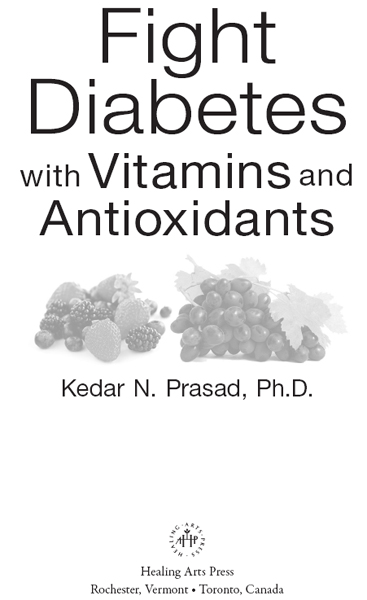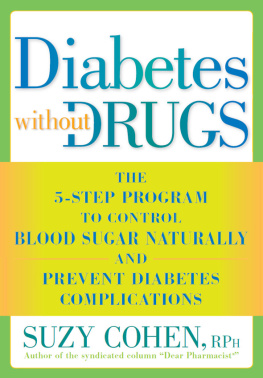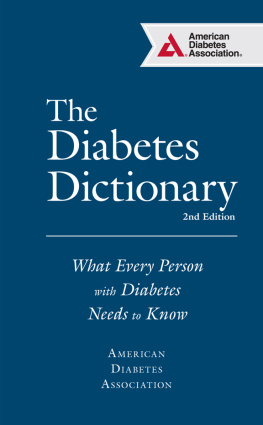
Fight Diabetes with Vitamins and Antioxidants

Dr. Prasad, a leading investigator and advocate for the role of micronutrients in cancer and neurodegenerative disorders, now succinctly presents an excellent biological rationale for the use of vitamins and antioxidants in the prevention and treatment of diabetes. His biological perspectives of micronutrients and concise meta-analysis of the existing data can help readers to consider antioxidants and proper agents in the fight against chronic disorders, especially for diabetes and cancer.
JAE HO KIM, M.D., PH.D., PROFESSOR OF RADIATION ONCOLOGY, HENRY FORD HEALTH SYSTEM, DETROIT, MICHIGAN
This is a most insightful presentation with many key ideas concerning both the prevention of onset and the deterrence of progression of diabetes. In view of the explosive increase in incidence of this disease, this book is especially timely. Emphasis is placed on inexpensive and noninvasive means by which diabetes patients can take command of a significant portion of their treatment. This makes the book especially valuable and relevant to a wide readership.
STEPHEN C. BONDY, PH.D., PROFESSOR, CENTER FOR OCCUPATIONAL AND ENVIRONMENTAL HEALTH, DEPARTMENT OF MEDICINE, UNIVERSITY OF CALIFORNIA, IRVINE
ACKNOWLEDGMENTS
I thank K. Che Prasad, M.S., M.D., for editing this work and for making very valuable suggestions.
Foreword
James Ehrlich, M.D.
I am a clinical advisor for Premier Micronutrient Corporation, a company formed to develop healthy products based upon the research efforts of a team of radiation biologists and micronutrient scientists led by Dr. Kedar N. Prasad. As a clinical associate professor in endocrinology whose major research has involved diabetics, I have had the privilege to witness the far-reaching activities of Dr. Prasad, a longtime professor at the University of Colorado, and the director for the Center for Vitamins and Cancer Research. I have always admired his teaching abilities, his honest research, and his leadership and passion for making a difference in the lives of individuals suffering from a great variety of disorders. He has published over two hundred papers, contributed chapters to many books, and authored or edited eighteen books of his own on the subjects of radiobiology, nutrition, and cancer.
For over three decades, Dr. Prasad has been remarkably convincing in promoting an underappreciated central thesis, one which I believe can greatly improve the health of millions of people the world over. He has consistently advocated the value of a scientifically based, multiple antioxidant approach to oxidative-stress-related disorders. This approach takes into consideration the disease state, kinetics (time-course) of therapy, efficacious tissue levels of micronutrients, and potential interactions with adjuvants (e.g., heavy metals). I have reviewed the protocols of many widely cited studies involving micronutrients as they relate to vascular disease, and I only wish that the authors of those studies had employed Dr. Prasad when constructing their study designs. The conclusions of a few of these fatally flawed contemporary studies might be quite different if they had done so!
Over the past several years there has been growing evidence that oxidative stress and inflammation are contributing factors to the development of various cardiometabolic disorders. In this, it has become increasingly clear that free radicals play an important role in the etiology and pathogenesis of diabetes and its complications. Contemporary research in vascular biology and diabetes has contributed to a better understanding of the link between oxidative stress and inflammation, and diabetic vascular complications and the progression of disease.
Much of this research has been focused on the generation of advanced glycation end-products: the result of non-enzymatic glycation and the oxidation of lipids and proteins. The deleterious effect of these by-products of metabolism on vascular beds and organs in patients with diabetes is an emerging area of intense activity, which has prompted a search for novel therapies that might disrupt the generation of such toxic species.
To compound these harmful effects, metabolic stress and tissue damage in diabetic patients can amplify oxidative damage, leading to a free-radical burden that can overwhelm natural scavenger mechanisms. In addition, atherogenic-oxidized lipoproteins, a by-product of diabetes, is a strong contributor to atherosclerosis and its progression in these patients. And with its dangerous partner in crimeinflammationa cascade of life-threatening events can be set in motion. This frequently begins with unstable plaque, which too often leads to coronary and peripheral vascular disease, stroke, kidney failure, and sudden death.
If it is true that substantial research has already addressed these issues, why does the nations preeminent micronutrient scientist/ radiation biologist, Dr. Kedar N. Prasad, need to revisit them by writing this book? In my view, there are four pressing reasons:
- The importance of the subject due to the magnitude of the problem: It is clear that diabetes and its increasingly prevalent precursor, metabolic syndrome, collectively representthe epidemic of the twenty-first century. The alarming and escalating magnitude of diabetes, given its spiraling health-related complications and expenses, makes it mandatory to reconsider better ways of managing and preventing the disease and its sequelae. That the disease is predominantly related to adverse trends in lifestyle and that it affords multiple targets of preventive therapy are factors that contribute to the vital importance of this subject.
- Knowledge gap: As I have stated, our understanding of the relationship between diabetes and its complications that are derived from oxidative stress and inflammation is growing. However, this research has not filtered down to the practitioner in a measurable way that would require the practitioner to recommend additional risk-reduction strategies for patients afflicted with diabetes and metabolic syndrome. And without a clear understanding of the inherent properties of individual micronutrients and how they are best utilized in a multiple-antioxidant strategy, the consumer is left with a dizzying array of noxious, illogical therapies. Consequently, there is currently little chance that patients (including proactive citizens) will understand why and how to incorporate a micronutrient plan to minimize oxidative stress and inflammation in the potential mitigation of their disease.
- Misconceptions about vitamins and micronutrients: The field of nutrition and the correct supplementation with proper micronutrients and vitamins has been extensively infiltrated by misconception and fallacy. With increasing frequency, practitioners are recommendingand vulnerable citizens are consumingindividual supplements, or combinations of supplements, which are unnecessary, ineffective, or downright damaging. In most cases, physicians do not address the nutritional needs of their patients. This is due to a lack of interest and/or training, or because these physicians may not be reimbursed for nutritional counseling. Without authoritative guidebooks (such as those on vitamins and micronutrients that Dr. Prasad has been publishing for decades), or input from knowledgeable clinicians, these misconceptions are self-perpetuating ones that take on the veneer of scientific fact while promoting useless and/or even harmful therapies.
Next page







